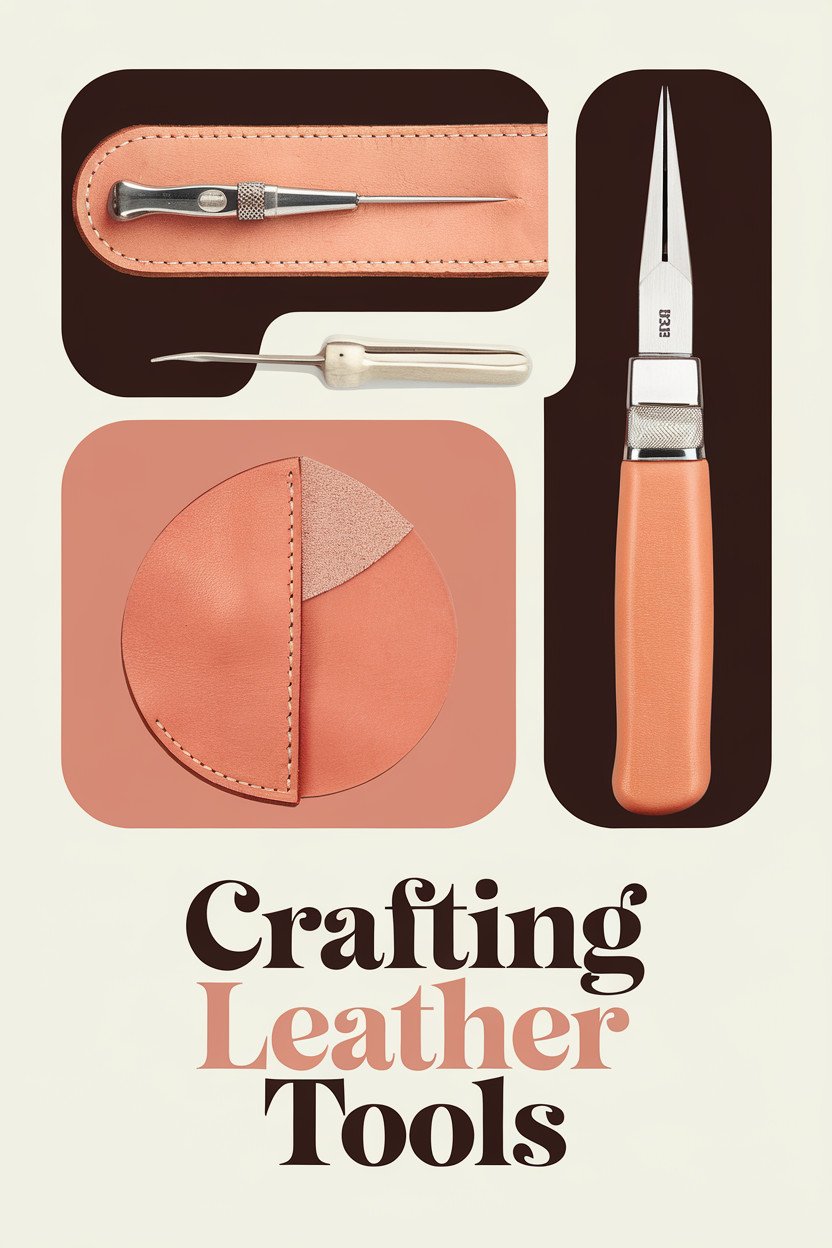Are you ready to explore the world of leather crafting? Whether you’re a seasoned leatherworker or just starting, having the right tools is crucial for achieving professional results. In this comprehensive guide, we will delve into the essential tools and supplies needed to create exquisite and unique leather projects. From cutting to embossing, we’ve got you covered with expert advice and recommendations.
- Having the right tools is crucial for achieving professional results in leather crafting.
- From cutting to embossing, there are many types of tools and supplies needed for leather crafting projects.
- Quality, versatility, and budget are important factors to consider when choosing the best leather crafting tools.
- There are various sources where you can purchase high-quality leather crafting tools and supplies both online and offline.
- Proper storage and maintenance are important for the longevity and functionality of your leather crafting tools.
Getting Started with Leather Crafting
Welcome to the exciting world of leather crafting! With the right tools and techniques, you can create beautiful and unique leather projects that will last a lifetime. Before you get started, it’s important to have the essential tools in your leatherworking kit.
- Leather cutting tools: Utility knives, rotary cutters, and leather shears are some of the cutting tools that you can use to cut leather with precision.
- Leather punching and hole making tools: These tools are important for creating holes in leather for various projects like belts, wallets, and bags. Hole punches, awls, and punches with interchangeable tips are some of the different types of leather punching tools you can use.
- Stitching tools: Needles, waxed thread, and stitching groovers are necessary tools for stitching leather projects, adding durability and style to your creation.
- Leather finishing and edging tools: These tools are used to refine and edge leather, giving your creation a polished and professional look. Some common tools include leather slickers, sandpaper, and bevellers.
- Embossing and stamping tools: To add unique designs and patterns to your leather projects, explore the world of embossing and stamping tools such as stamping tools, embossing wheels, and mallets.
- Leather dyeing and coloring tools: These tools allow you to personalize your projects and bring them to life. Applicators, brushes, and leather paints are some of the essential tools for dyeing and coloring leather.
- Leather carving and tooling tools: These tools are great for transforming ordinary leather into intricate works of art. Swivel knives, bevelers, and stamping tools are some of the different types of leather carving tools you can use.
- Leather burnishing and polishing tools: Achieving a smooth and polished finish on your leather projects requires the right tools. Burnishing tools like edge slickers, gum tragacanth, and canvas, as well as polishing techniques, give your creations a professional touch.
- Leatherworking accessories and miscellaneous tools: In addition to the essential tools, there are various accessories and miscellaneous tools that can enhance your leather crafting experience. Discover items like edge bevelers, strap cutters, and rivet setters that can make your projects more efficient and convenient.
With these essential tools in your leather crafting kit, you’re ready to embark on your creative journey. Keep reading to learn more about each tool and how you can use them to create stunning leather projects.
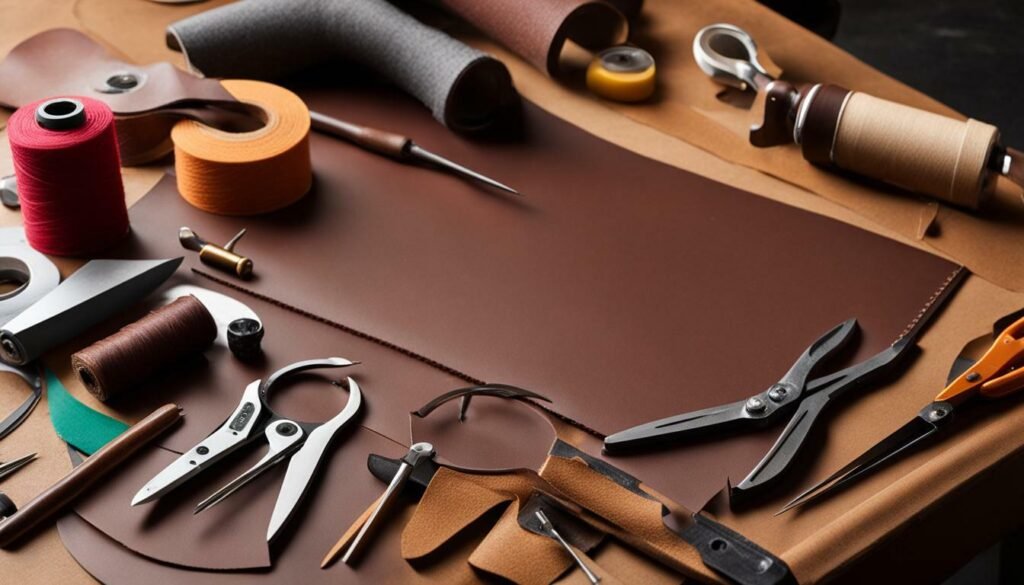
When it comes to leather crafting, precision is crucial for achieving professional results. Therefore, it’s essential to have the right cutting tools in your leatherworking arsenal. Here are some of the most commonly used cutting tools in leather crafting:
- Utility knives: These versatile knives can be used to make straight or curved cuts in leather.
- Rotary cutters: These handheld cutters have a circular blade that can cut through multiple layers of leather at once.
- Leather shears: Similar to regular scissors, leather shears are designed specifically for cutting leather and have a strong, sharp blade.
It’s important to choose cutting tools that are appropriate for the thickness and type of leather you’re working with. Here are some tips for using cutting tools in leather crafting:
- Always use a cutting mat when using cutting tools to protect your work surface and ensure clean cuts.
- Practice making test cuts on scrap leather before cutting into your project.
- Keep your cutting tools sharp for optimal performance and safety.
Now that you know the basics of cutting tools for leather crafting, it’s time to explore other essential tools and techniques to take your leatherworking skills to the next level.

Creating holes in leather is an essential step in crafting various projects, such as belts, wallets, and bags. There are different types of leather punches and hole making tools that you can use, depending on the size and shape of holes needed. Some of these tools include:
- Hole punches: They come in different sizes and shapes and can be manual or automatic.
- Awls: These pointed tools are useful for creating small holes or for marking stitching lines.
- Punches with interchangeable tips: These tools can create holes of different sizes and shapes and are useful for more complex designs.
Before punching holes, make sure to mark the location of each hole and use a cutting mat underneath to avoid damaging your work surface. You can also use a mallet or a hammer to ensure that the punch goes through the leather cleanly.
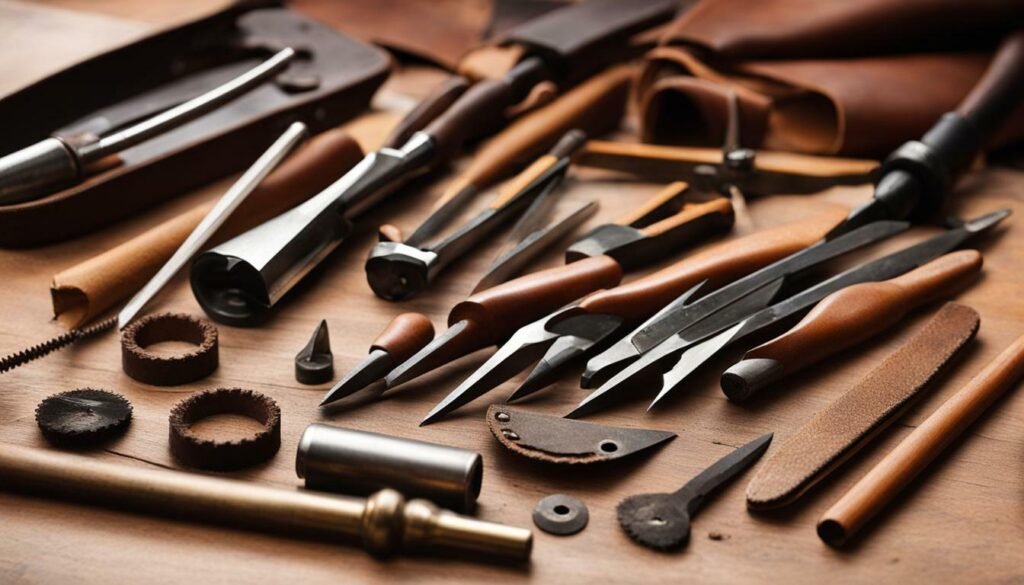
The right leather punching and hole making tools can help you achieve precise and clean holes, adding to the overall professional look of your leather projects.
Stitching Tools and Techniques for Leather Crafting
Stitching is an essential part of leather crafting, and having the right tools is crucial for achieving professional results. Here are some of the stitching tools and techniques that you’ll need to know:
- Needles: Leather needles are thicker and stronger than regular needles and come in different sizes. Choose a needle that fits the thread you’re using.
- Waxed Thread: Waxed thread is used for hand-stitching leather and is available in different thicknesses and colors. It adds durability and a decorative touch to your projects.
- Stitching Groovers: These tools are used to create a groove along the stitching line and prevent the thread from sticking out too much. They come in different sizes to accommodate different thread sizes.
- Saddle Stitching: This technique involves two needles and a single length of thread to create a strong and durable stitch. It’s perfect for joining two pieces of leather or creating a decorative border.
- Lacing: Lacing is a decorative way to join leather pieces and can be used in place of stitching. It involves punching evenly spaced holes on either side of the leather and then threading a lace through the holes.
Remember to keep your stitching tools sharp and clean to ensure smooth and accurate stitching.

When it comes to leather crafting, the finishing touches can make all the difference in the appearance of your projects. To achieve a polished and professional look, it’s important to have the right tools for edging and refining your leather.
One essential tool for finishing leather is a leather slicker, which is used to smooth out rough edges and creases. Sandpaper is also useful for refining edges and creating a smooth surface. Bevellers are another edging tool that can create a rounded edge on your leather projects.
When it comes to coloring and finishing your leather, you’ll need to invest in leather dyes, sealers, and finishes. These can be applied with brushes, daubers, or spray guns to achieve a desired color and sheen.
Another important tool for finishing leather is a burnisher, which is used to create a shiny and smooth surface on edges and flat areas. Edge slickers and gum tragacanth are commonly used burnishing tools, while canvas is used to smooth out larger areas.
Proper finishing and edging can elevate your leather creations and ensure they last for years to come.
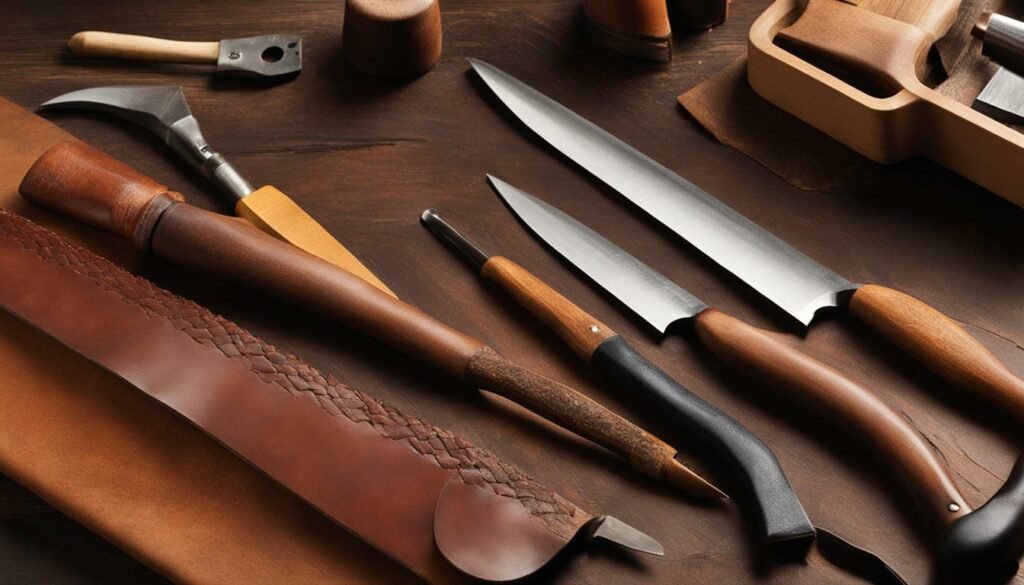
Embossing and Stamping Tools for Leather Crafting
If you want to add a touch of personality to your leather projects, embossing and stamping tools are essential. These tools allow you to create unique designs, logos, and patterns on leather surfaces.
There are a variety of embossing and stamping tools available in the market, ranging from simple handheld stamps to intricate electric press machines. Some common embossing tools are:
- Stamps with letter and number sets
- Embossing wheels with various designs
- Mallets to create a deeper impression
Depending on the tool you choose, you can create a variety of designs on leather surfaces, from simple monograms to intricate patterns.
When using embossing and stamping tools, it’s important to be gentle and precise. Apply consistent pressure to achieve an even impression, and aim for a clean and crisp design.
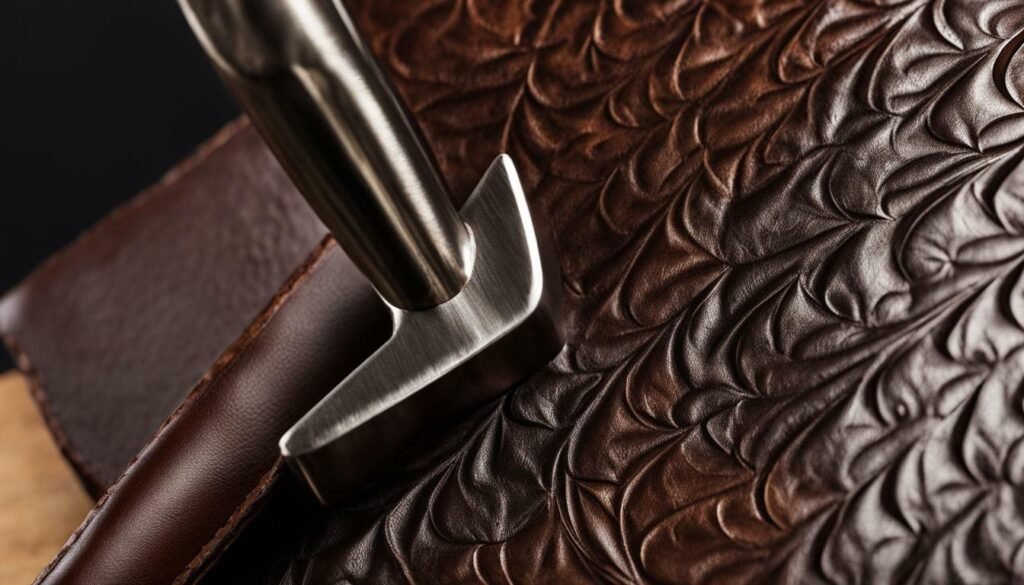
Remember, embossing and stamping tools require a bit of skill and patience, but the results can be stunning. Experiment with different designs and techniques to create truly unique leather creations.
Leather Dyeing and Coloring Tools
If you want to add a pop of color to your leather projects, you’ll need the right tools. Here are some essential leather dyeing and coloring tools:
- Applicators: Use brushes, sponges or daubers to apply dye or paint to your leather.
- Leather Paint: Specially formulated for leather, these paints come in a variety of colors and finishes such as matte and gloss.
- Leather Dye: Available in both oil and water-based formulations, leather dye is more pigmented than paint and penetrates the leather for a longer-lasting color.
- Acrylic Resolene: A protective coating that helps seal and protect the color from fading or rubbing off.
When using leather dye or paint, consider using a test piece of leather to ensure the color and coverage is what you want before applying it to your final project. And always work in a well-ventilated area and wear gloves to protect your hands.
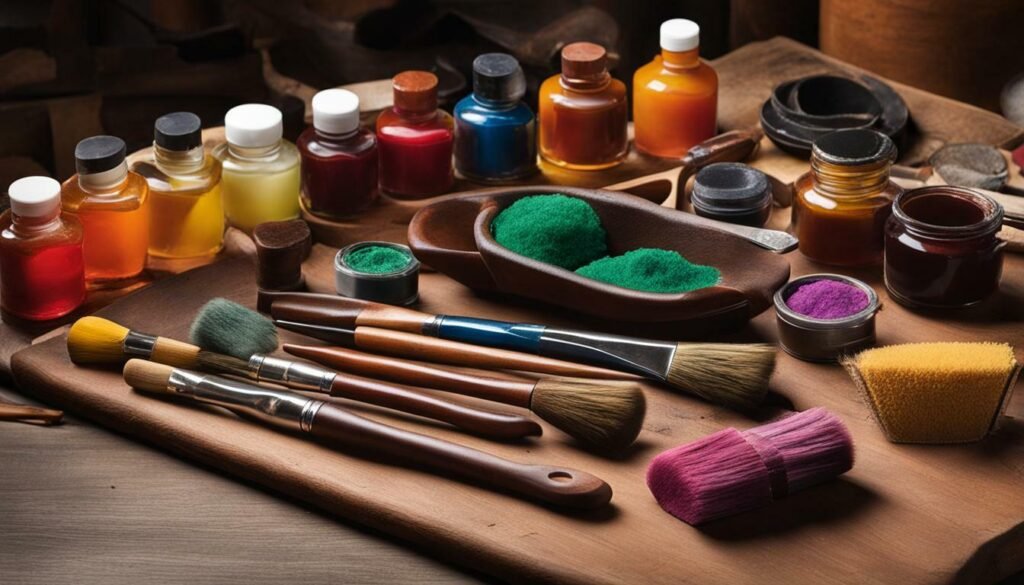
Leather Carving and Tooling Tools
Leather carving and tooling can take your projects to the next level by adding intricate designs and patterns. It requires special tools to create these designs, such as:
- Swivel knife: Used for making precise cuts and creating contours in the leather.
- Bevelers: Used for creating depth in the leather and adding a three-dimensional effect to the design.
- Stamping tools: Used for creating various patterns and designs in the leather.
When using these tools, it’s important to be patient and work slowly to achieve the desired effect. Practice on a scrap piece of leather before starting on your actual project. The key to a successful carving or tooling project is to have a clear idea of the design you want to create and to work meticulously to bring it to life.
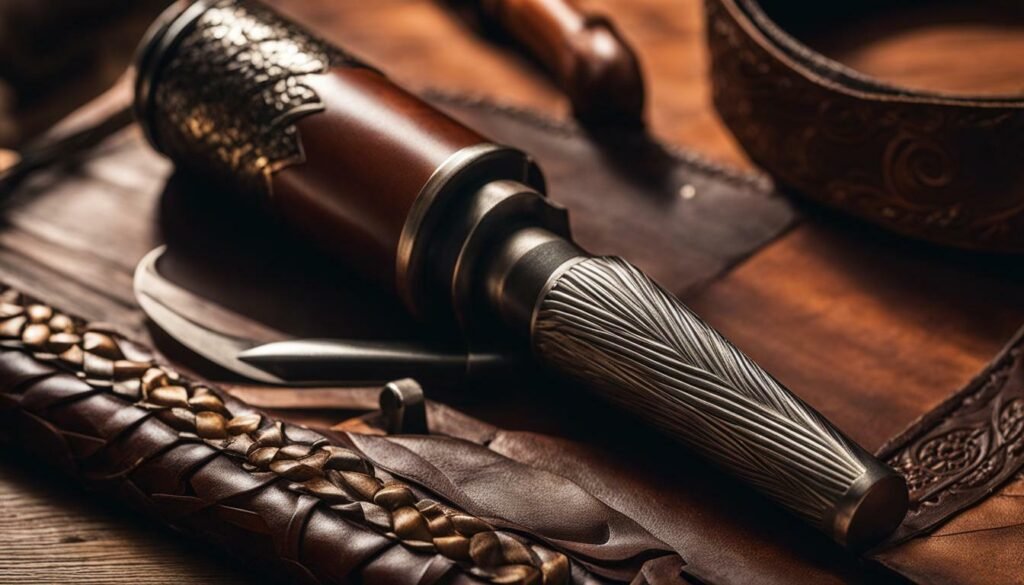
Don’t forget to maintain your tools by sharpening them regularly and storing them in a cool, dry place away from moisture and dust. A well-maintained tool will not only last longer, but it will also make it easier to achieve the desired results.
Leather Burnishing and Polishing Tools
Once you’ve completed your leather project, you’ll want to give it a smooth and finished look. This is where burnishing and polishing come in, using tools such as edge slickers, gum tragacanth, and canvas.
Edge slickers are used to smooth out rough edges and create a polished finish. They come in different sizes, and you’ll want to choose one that fits comfortably in your hand. Gum tragacanth is a natural gum that creates a protective layer on the leather and helps it retain its shape. It’s often used before burnishing to make the edges more pliable and easier to work with.
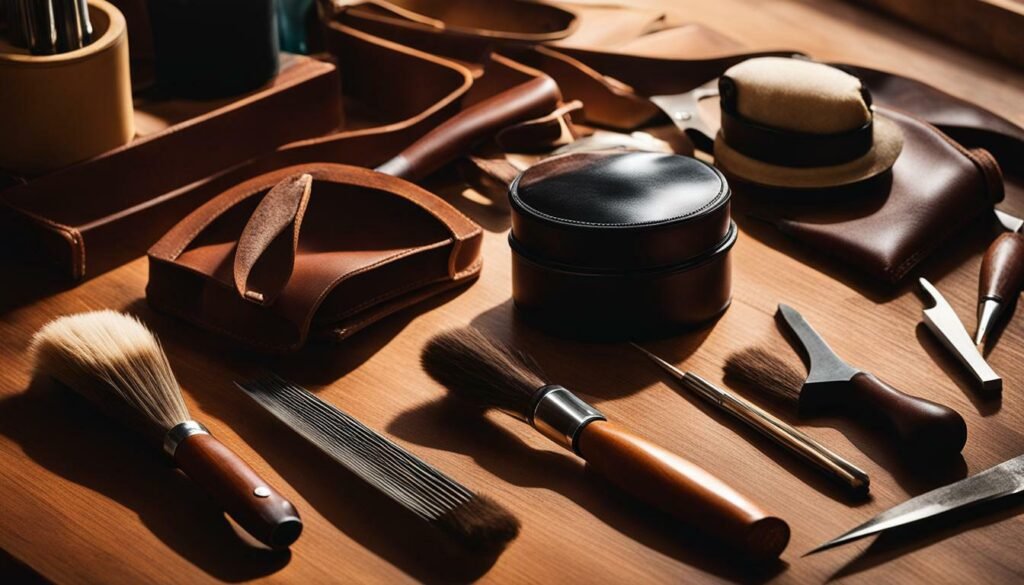
Canvas is another burnishing tool that can be used to create a smooth and polished finish. It’s often used to burnish larger areas of leather, such as belts or bags. You can also use it with water or a burnishing solution to achieve a more polished look.
When it comes to polishing, there are various tools and materials you can use, such as beeswax, carnauba wax, or leather balm. These products help protect the leather and give it a subtle shine. You can apply them with a soft cloth or a dauber brush. Be sure to use a product that’s appropriate for the type of leather you’re working with.
- Edge slickers are used for smoothing rough edges and creating a polished finish.
- Gum tragacanth creates a protective layer on leather and helps retain its shape.
- Canvas can be used to burnish larger areas of leather.
- Beeswax, carnauba wax, or leather balm can be used to polish and protect the leather.
With the right burnishing and polishing tools, you can achieve a professional finish on your leather projects.
Leatherworking Accessories and Miscellaneous Tools
In addition to the essential leather crafting tools, there are several accessories and miscellaneous tools that can make your projects more efficient and convenient.
- Edge Bevelers: Used to round off the edges of your leather projects for a smoother, more polished look.
- Strap Cutters: Designed to cut straps and strips of leather with ease and precision.
- Rivet Setters: Used to set and secure rivets onto your leather projects.
- Leather Stamps: Allow you to create unique designs on your leather projects, such as initials or logos.
- Stitch Markers: Help you create evenly spaced stitching holes on your leather projects.
These accessories and tools can make a significant difference in the outcome of your projects, so it’s worth investing in them.
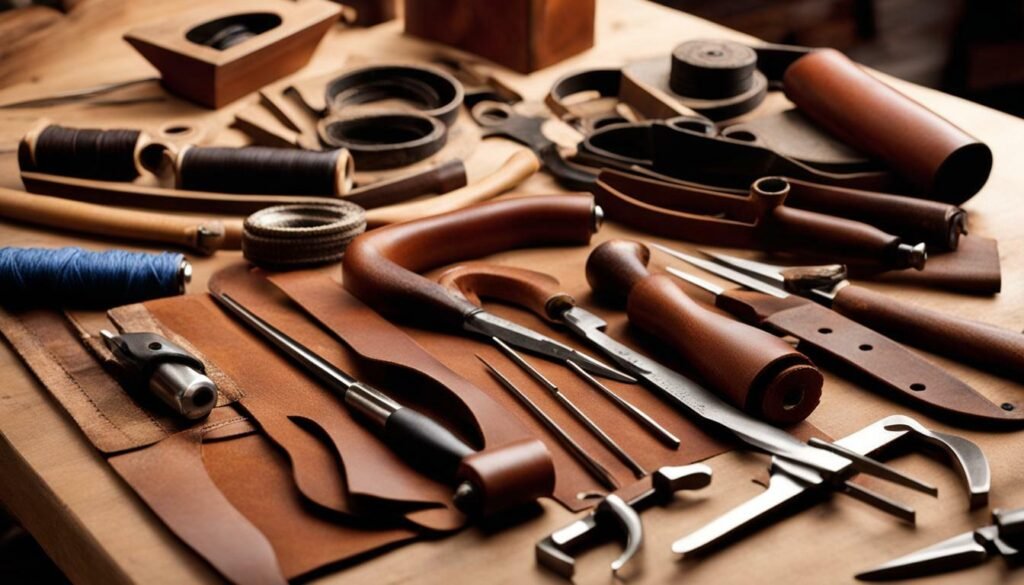
Don’t overlook the importance of proper storage and maintenance of your leatherworking tools and accessories. Keep them organized and protected in a dedicated tool storage box or kit, and periodically clean and oil them to ensure their longevity and functionality.
Leathercraft Tool Storage and Maintenance
Now that you have your essential leather crafting tools, it’s important to store and maintain them properly to ensure their longevity and functionality. Here are some tips:
- Designate a specific storage area for your tools, such as a tool box or a drawer, to keep them organized and easily accessible.
- Clean your tools after each use with a soft cloth and store them dry to prevent rust and corrosion.
- Apply a light coat of oil or wax to metal tools to protect them from rusting.
- Sharpen cutting tools regularly to maintain their effectiveness and safety.
- Replace any worn or damaged tools to prevent injury and ensure professional results.
By following these simple storage and maintenance practices, you’ll ensure your leatherworking tools are always in top condition and ready for your next creative project.

Investing in high-quality leather crafting tools is essential for achieving professional results and getting the most out of your creative projects. But with so many types of tools available, how do you choose the best ones for your needs? Here are some factors to consider when building your leather tool kit:
- Quality: Look for tools made from durable materials that will stand the test of time.
- Versatility: Consider tools that can be used for a variety of projects and techniques.
- Budget: Determine your budget and search for tools that provide the best value for your money.
- Ergonomics: Choose tools that fit comfortably in your hand and won’t cause fatigue during use.
- Brand reputation: Research the brands you’re considering and read reviews from other leatherworkers to ensure you’re investing in quality tools.
Remember, the best leather crafting tools for you may vary depending on your specific projects and skill level. It’s important to assess your needs and choose tools that will aid you in your creative journey. And don’t forget to store and maintain your tools properly to ensure their longevity and functionality.
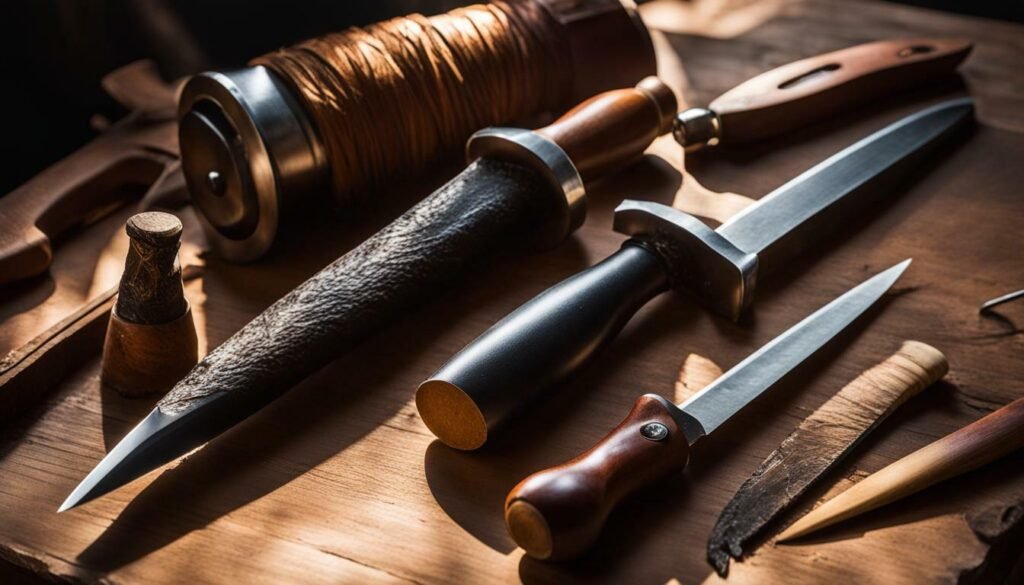
Now that you have a good understanding of the essential tools needed for leather crafting, it’s time to find a reliable supplier to purchase them from. Here are some places you can look for high-quality leather crafting tools and supplies:
- Specialty leather stores: These stores have a wide variety of leatherworking tools and supplies and can offer expert advice on which tools to choose for your project.
- Online retailers: Online shopping for leather crafting tools and supplies is convenient and offers a wider range of options. Make sure to check reviews and ratings before purchasing from an online vendor.
- Second-hand marketplaces: You may be able to find gently used leatherworking tools and supplies on platforms like eBay or Craigslist at a lower cost.
- Craft and hobby stores: While these stores may not have as extensive of a selection as specialty leather stores, they often have basic leather crafting tools and supplies.
When choosing a supplier, look for one that offers quality products at a reasonable price and has good customer service. Don’t forget to compare prices and read reviews before making a purchase. With a little research, you can find the perfect supplier to help you embark on your leather crafting journey.
FAQ
What are the essential tools for leather crafting?
The essential tools for leather crafting include cutting tools, stitching tools, leather punching tools, leather finishing tools, embossing and stamping tools, dyeing and coloring tools, carving and tooling tools, burnishing and polishing tools, as well as accessories and miscellaneous tools.
How do I choose the best leather crafting tools?
When choosing leather crafting tools, consider factors such as quality, versatility, and your budget. Look for tools that are durable and offer a range of functions to meet your specific crafting needs.
Where can I buy leather crafting tools and supplies?
You can find leather crafting tools and supplies from various sources, both online and offline. Some popular options include specialized leathercraft stores, online marketplaces, and artisanal suppliers.
How do I store and maintain my leather crafting tools?
To ensure the longevity and functionality of your leather crafting tools, store them in a clean and dry environment. Consider using tool rolls, boxes, or racks to keep them organized. Additionally, regularly clean and oil your tools to prevent rust and maintain their performance.
